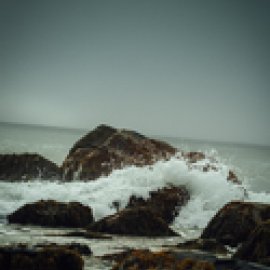A Rescue Blueprint: How the Ocean Can Save Civilization pt 2 of 2
-
English
-
ListenPause
[intro music]
I’m Peter Neill, Director of the World Ocean Observatory.
A year ago, I began to prepare a plan for ocean conservation in the context of failure by the international community to define a coherent strategy built on science and policy that would commence the transformational change required by the deteriorating condition of the world ocean. It was to be a plan not otherwise institutionally proposed by the UN, national or state governments, a personal agenda if you will, composed of some fifty years of investigation and advocacy for the preservation and sustainability of the sea that connects all things. Bold, but hopeful.
World Ocean Radio was to be the platform for distribution. The considerations I proposed to discuss in the first edition were: context (the water cycle and climate consequence); emerging technology and innovation; eco-finance (natural asset value and novel financial instruments); ocean literacy (education and trans-generational engagement); advocacy (political will through global communications); ocean connections (shared understanding through cultural traditions); articulation of a new ocean ethos (new values, structures, and behaviors); and a suggested vision for a new hydraulic society as a paradigm for the future of human survival. Impossible? But necessary.
At the beginning, I invoked Jacques Cousteau who, in his inspirational prologue to his book, The Silent World, writes “We have tried to find the entrance to the great hydrosphere.” I was of the opinion then that our progress had not lived up to Cousteau’s observation, and I had every reason to conclude that we needed a new declaration of intent to accelerate his instruction. I feel the same today, after thirty-two parts of the [RESCUE] plan. What will it take to break the old paradigm and build the new?
To understand and define my personal commitment, I devised a checklist of steps, a series of questions to ask and to assemble the answers into a practical, personal plan for engagement to maximize my contribution to the solution. I considered the following as an ordered analysis of where I come from, what is my capacity, what is the strength of my commitment and purpose, and what moves me best to action.
The considerations were as follows:
• My Time – My Life in a Continuum of History
• My Space – My Place in a Context of Change
• My Self-Knowledge – My Education through Curiosity and Inquiry
• My Strength of Purpose – My Energy through Vocation and Avocation
• My Ambition and Definition of Reward
• My Experience and Found Wisdom in Nature
• My Knowledge Articulated and Shared through Action and Communication
• Kindness – My Expression of Humanism and Respect
• My Pathways in the Landscape of Choice
• My Decision and Commitment to Act
• My Involvement in Citizenship and Community through Effective EngagementIt was an interesting process that clarified direction, focused capacity, and suggested a personal call to a specific plan of action. There were many possible courses to follow, privileged but personal and possible. If I, like any other, was standing before the entrance to the “great hydrosphere,” which path would I take to enable success? As with the ocean, there are myriad conditions and choices, a million paths to follow to get from one place to another, each one unique, each one possible once chosen.
What we cannot allow is indifference or confusion. The evidence of that choice is all around us. No, we must come together, as individuals, as families, as villages and towns, as governments, and as international collectives, to immerse ourselves in the all-sustaining ocean. There is no single choice, but one of them is mine, one of them is yours, then ours, and by it, we become a fluid school of salvors and saviors, of sailors and savers, as we dive in to RESCUE: R for renewal, E for environment, S for society, C for collaboration, U for understanding, and E for engagement.
I’ll meet you out there: in the swim.
We will discuss these issues, and more, in future editions of World Ocean Radio.
[outro music]
We have launched a Substack to share a plan for specific action and public participation. In this two-episode arch we reintroduce listeners to RESCUE: a 33-part series outlining a plan for specific action and public participation, providing a blueprint for how the ocean can save civilization. In the series we cover ocean topics related to Science, Policy, Energy and Technology, Finance and Ecosystem Services, Education and Ocean Literacy, Culture, and Human Health. RESCUE stands for: Renewal, Environment, Society, Collaboration, Understanding, Engagement. Join the conversation on Substack for weekly free 4-minute reads: substack.com/@oceanblueprint
About World Ocean Radio
World Ocean Radio is a weekly series of five-minute audio essays available for syndicated use at no cost by college and community radio stations worldwide. Peter Neill, Director of the World Ocean Observatory and host of World Ocean Radio, provides coverage of a broad spectrum of ocean issues from science and education to advocacy and exemplary projects.
World Ocean Radio
14 Years, 700+ Episodes
Ocean is climate
Climate is ocean
The sea connects all things
- Login to post comments



